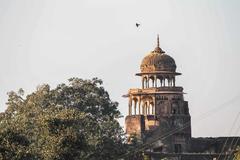
Visiting Bajrangarh Fort: Hours, Tickets, and Historical Insights in Guna, India
Date: 24/07/2024
Introduction
Bajrangarh Fort, also known as Jharkon, is an iconic historical site situated in the Guna District of Madhya Pradesh, India. Constructed around 1600 AD by King Jai Narayan of the Nandvanshi Ahirs, the fort stands as a testament to the region’s rich cultural and architectural heritage (Tourist in India). Located strategically on a high hill near the Chapet River, this fort has been a significant military and administrative center throughout its history. From its role as the headquarters of a mahal of the Chanderi Sarkar to its dramatic siege in 1816 AD by General John Baptiste, the fort’s history is as storied as it is compelling (Wikipedia). Today, despite its ruins, Bajrangarh Fort continues to attract history enthusiasts and casual travelers alike, offering a unique glimpse into India’s storied past. This guide aims to provide comprehensive information about visiting the fort, including its history, visitor tips, and nearby attractions, ensuring a well-rounded and enriching experience.
History of Bajrangarh Fort
Origins and Construction
Bajrangarh Fort was constructed around 1600 AD by King Jai Narayan of the Nandvanshi Ahirs, a branch of the Gagron princely state (Tourist in India). This period marked the fort’s initial establishment as a significant military and administrative center.
Architectural Layout
Strategically situated at an altitude of 92.3 meters (303 feet) on a high hill, the fort spreads over 72 bighas of land. It is located approximately 10 kilometers (6.2 miles) from Guna on the Guna to Aron road, near the banks of the Chapet River (Wikipedia). The fort’s design includes four gates positioned in four cardinal directions, providing access to various internal structures such as Moti Mahal, Rangmahal, Ram Mandir, and Bajrang Mandir, which remain intact to this day (Tourist in India).
Historical Significance
During its prime, Bajrangarh Fort served as the headquarters of a mahal (administrative division) of the Chanderi Sarkar. This highlights its importance in regional governance and military strategy. The fort’s location and robust construction made it a formidable stronghold in the region (Wikipedia).
The 1816 Siege
One of the most significant events in the fort’s history occurred in 1816 AD during the reign of Raja Jai Singh. Maharaja Daulat Rao Sindhia of the Gwalior state dispatched his General, John Baptiste, to attack the fort. The ensuing battle resulted in the defeat of Raja Jai Singh and the subsequent destruction of the fort (Tourist in India). This event marked a turning point, leading to the fort’s decline and eventual ruin.
Post-Siege Era
Despite the destruction, several structures within the fort complex have survived. Notably, the Moti Mahal, Rangmahal, Ram Mandir, and Bajrang Mandir remain intact, offering a glimpse into the fort’s past grandeur (Wikipedia). Additionally, a large stepwell within the fort complex, used for storing drinking water for horses, still exists, showcasing the advanced water management systems of the time (Tourist in India).
Cultural and Religious Aspects
The fort also houses an ancient temple, frequented by local inhabitants. This temple, believed to have been constructed by the Nandvanshi Ahirs, adds a religious dimension to the fort’s historical significance (Wikipedia). Another notable religious structure within the fort is the Bisbhuji temple, believed to have been built in 1775 by the Maratha rulers (Tourist in India).
Preservation and Current State
Today, Bajrangarh Fort stands in ruins, yet its bastions and remaining structures continue to evoke a sense of its historical importance. The fort’s current state serves as a testament to its storied past and the various historical events that have shaped its existence (Tourist in India).
Visitor Information
Visiting Hours and Tickets
Bajrangarh Fort is open to visitors from 9:00 AM to 5:00 PM daily. Entry is free, but donations for maintenance are welcome.
Accessibility and Transportation
The fort is accessible via regular buses from Guna town, and visitors can also hire taxis to reach the site. The nearest railway station is Guna, while the closest airport is in Bhopal, approximately 188 kilometers away (Tourist in India).
Travel Tips
- Wear comfortable shoes: The fort’s terrain can be uneven, so sturdy footwear is recommended.
- Carry water and snacks: There are limited facilities within the fort complex.
- Best time to visit: The cooler months from October to March are ideal for exploring the fort.
- Photography spots: Capture panoramic views from the fort’s highest points and the intricate details of the remaining structures.
Nearby Attractions
- Guna Historical Sites: Explore other historical sites in Guna, such as the Bajrangarh Temple and the Guna Museum.
- Chapet River: Enjoy a scenic walk or picnic by the riverbanks.
FAQ
Q: What are the visiting hours for Bajrangarh Fort?
A: The fort is open from 9:00 AM to 5:00 PM daily.
Q: Is there an entry fee?
A: Entry is free, but donations for maintenance are welcome.
Q: What is the best time to visit Bajrangarh Fort?
A: The cooler months from October to March are ideal for exploring the fort.
Q: How can I reach Bajrangarh Fort?
A: The fort is accessible via buses from Guna town, taxis, and the nearest railway station is Guna. The closest airport is in Bhopal, about 188 kilometers away.
Conclusion
The history of Bajrangarh Fort is a tapestry of architectural brilliance, strategic importance, and cultural significance. From its construction by the Nandvanshi Ahirs to its role in regional governance and its eventual decline following the 1816 siege, the fort’s story is a reflection of the broader historical currents that have shaped the region. Today, the ruins of Bajrangarh Fort continue to attract visitors, offering a window into the past and a reminder of the fort’s enduring legacy. Plan your visit to this remarkable site and immerse yourself in its rich heritage.
References
- Tourist in India, 2023, Bajrangarh Fort
- Wikipedia, 2023, Bajrangarh Fort
